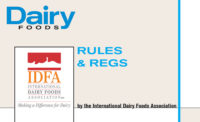
According to leading dairy promotion organizations National Dairy Council (NDC) and Dairy Management Inc. (DMI), milk and other dairy products can and should be an important part of the school experience.
Leinenbach:Overall, school officials and food service personnel have embraced our efforts to improve milk programs, sometimes sanctioned as the “ revolution” because of the drastic change from the way we used to do business with schools. We have learned the importance of building and maintaining relationships with key school officials and food service personnel. Last year, our Michigan Division began publishing a newsletter specifically for this group — “School MOOS — News you can use.” It is an informative tool which includes legislative updates, continuing and upcoming marketing programs, nutritional information and other milk facts.
Soda’s out, milk’s in
The milk industry has launched a new campaign that is taking a different approach to appeal to teenagers. With messages supported by the American Dietetic Association and the School Nutrition Association, Body By Milk is encouraging teens to grab lowfat milk instead of sugary sodas because — along with staying active and eating right — it may help them achieve a healthy weight.
